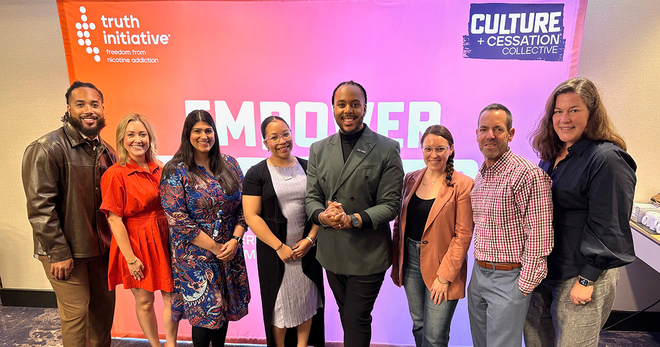5 strategies for passing local laws against flavored tobacco
While smoking in the U.S. has plunged in recent decades, the use of flavored tobacco products, particularly menthol cigarettes, has increased.
Young people — especially African-American youth — are getting hooked on tobacco by first trying these flavored products. In fact, in 2014, the majority of high school students who smoked a cigarette in the past 30 days used menthol cigarettes, mint-flavored products that are easier to smoke and harder to quit. In middle school, nearly 50 percent those who smoked in the past 30 days used a menthol product.
While the federal government passed a national ban in 2009 on flavored cigarettes, it exempted menthol cigarettes and did not include flavor restrictions on other tobacco products, including e-cigarettes, cigars, smokeless or hookah. Since then, cities have stepped in to enact their own flavor bans.
In 2017, five cities passed local menthol bans and other types of flavored tobacco product restrictions. To better understand what it takes to pass these policies, Truth Initiative® spoke to public health officials in 12 cities across the Northeast, West and South for a new Truth Initiative report, “Menthol and flavor policies: Lessons from the field.” Some of the cities had passed menthol restrictions, others had considered the measures and some had not taken any steps toward the policies.
Based on lessons learned from speaking to local officials, the report recommends five strategies:
1. Tailor messages to the area
“What works for one city may not work for all,” the report states. “However, by engaging with the community and local leaders, public health advocates can tailor a message that resonates with the local area.”
Cities should consider the following:
City size: While smaller cities may face competing priorities, they may also have fewer retailers and can work directly with them to brainstorm on alternative products to sell. Larger cities may benefit from larger staffs, including specialized people such as an epidemiologist, who can collect data about how a restriction would affect the city.
Products: Menthol products are the most common, but cities should consider which products to emphasize. Some cities have successfully passed laws banning the sale of all flavored tobacco products, including menthol. Other cities have focused on restricting flavored tobacco products to adult-only retail tobacco stores or creating buffer zones around schools.
Population: Flavored tobacco products, which are often starter products, particularly affect youth and African-Americans. In 2014, more than 80 percent of teenagers reported that the first tobacco product they used was a flavored product, according to the report. Among African-Americans, 95 percent of current smokers smoke menthols. Several cities with African-American populations found it valuable to take the time to explain to people how the tobacco industry has exploited their community. Industry tactics have included advertising more in African-American neighborhoods and publications, donating money to African-American groups and providing cheaper prices or free cigarette giveaways. “It doesn’t take long, but it is important to educate the community, and it often can get them energized around the issue,” the report says.
Geography and culture: It’s important to know a city’s history and culture surrounding tobacco. For example, cities in states that have been big tobacco producers have focused on the health effects of tobacco.
Political timing: Know how a city and elected officials have responded to tobacco control policies in the past. Consider which officials might be interested in leaving a positive legacy or creating a healthier community. Nearly every participant interviewed for the report said educating political leaders is critical. Many of these leaders don’t use tobacco and are unaware of all the different flavored products — little cigars, hookah or e-cigarettes — or the huge popularity of menthol.
2. Engage the community and allies
Getting the broader community involved is key. Advocates need to show political leaders that this is not a fringe movement and consider ways to partner with community leaders, youth, and retail and business. In addition, national organizations like Truth Initiative, the Campaign for Tobacco Free Kids, National African American Tobacco Prevention Network and the African American Tobacco Control Leadership Council can provide guidance and support.
It is important to meet with the community. Many participants felt meetings were “a valuable way to raise awareness around industry tactics and frame the issue as one of social justice,” the report states.
Communities have found it helpful to use themes that focus on helping kids, and tobacco and flavors as a social justice issue, at the meetings. For example, one interviewee reported that at a city council meeting an advocate threw a collection of flavored tobacco products and candy on a table. “The uniformly brightly colored, ‘fun-shaped’ packaging, boasting great fruity flavors, made it almost impossible to tell which were tobacco and which were candy without closer inspection,” according to the report.
3. Gather resources and carefully construct legislation
Cities can successfully enact flavor restrictions even if there is not dedicated funding for the project. Think about existing resources, like public health programs, and outside funding, such as grants. In addition, consider a city’s situation and tailor the message. Some cities gathered local data, while others relied on national statistics. However, stories often are more valuable than data. Consider having teenagers talk about the flavored products that surround them every day.
4. Anticipate opposition
Consider how opponents are going to respond to the messages and be ready with responses. Some common arguments include: restrictions hurt local businesses, take away people’s freedoms, and that tobacco is already over-regulated. Respond with science, statistics and stories. Again, if the tobacco control community educates political leaders, they will be less likely to believe the industry’s arguments.
Know that the tobacco industry may threaten lawsuits. Most participants said they received some sort of contact from tobacco companies when they tried to pass flavor restrictions. Some reported industry representatives sitting silently at city meetings, while others said they appeared to be organizing local people, providing them talking points. “Cities underlined the importance of having a policy that can stand up to legal scrutiny and strongly recommended talking to city attorneys about the policy in advance,” the report says.
5. Plan for implementation and sustainability
The work is not done after successful passage of tobacco restrictions. Communities need to plan how the city will implement and enforce the policy. Consider how city agencies and local law enforcement can be involved. Think about the resources needed to continue the efforts. Make plans for ongoing education campaigns to keep the momentum going.
Interview participants highly recommended these “back-end plans” to continue the community’s support for flavor restrictions after the laws took effect. “As some communities saw first-hand, without this back-end planning, hard-won policy restrictions could potentially be overturned by new city councils,” the report states.
By carefully considering the unique aspects of the city and developing a strong plan, communities can raise awareness of flavored products and pass menthol and flavor restrictions. For more information, read our report, “Menthol and flavor policies: Lessons from the field.”
More in tobacco prevention efforts
Want support quitting? Join EX Program
By clicking JOIN, you agree to the Terms, Text Message Terms and Privacy Policy.
Msg&Data rates may apply; msgs are automated.


